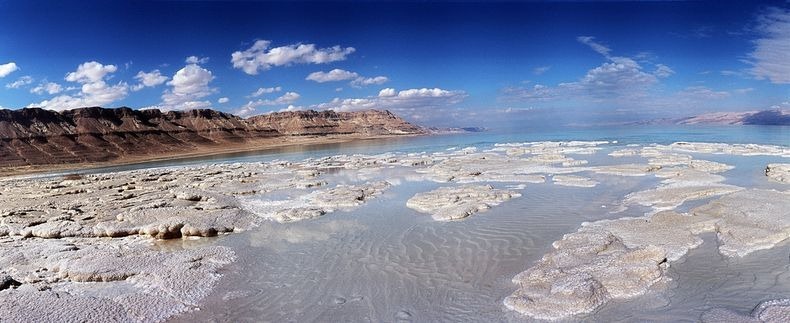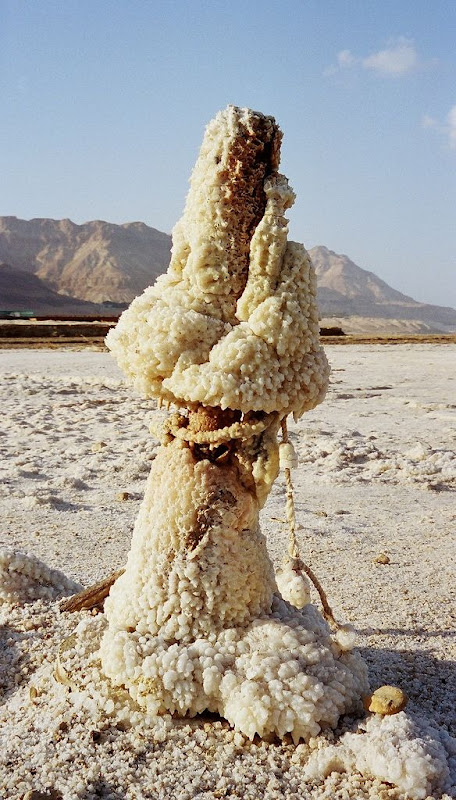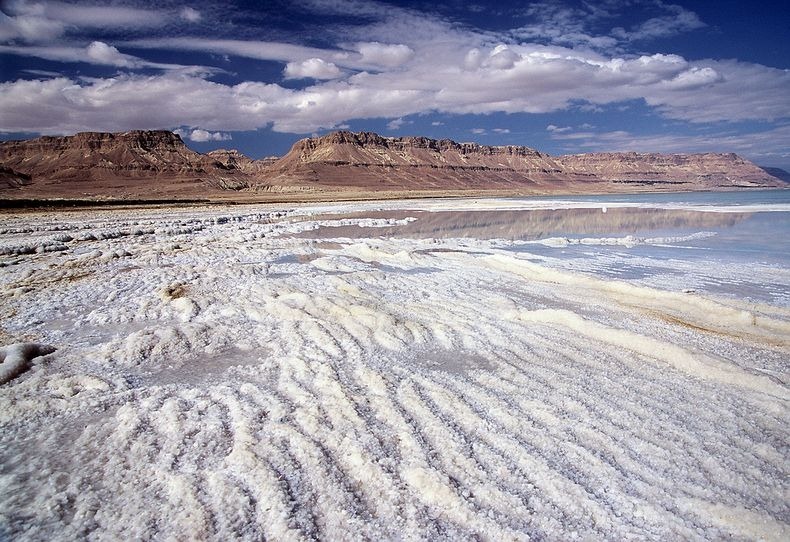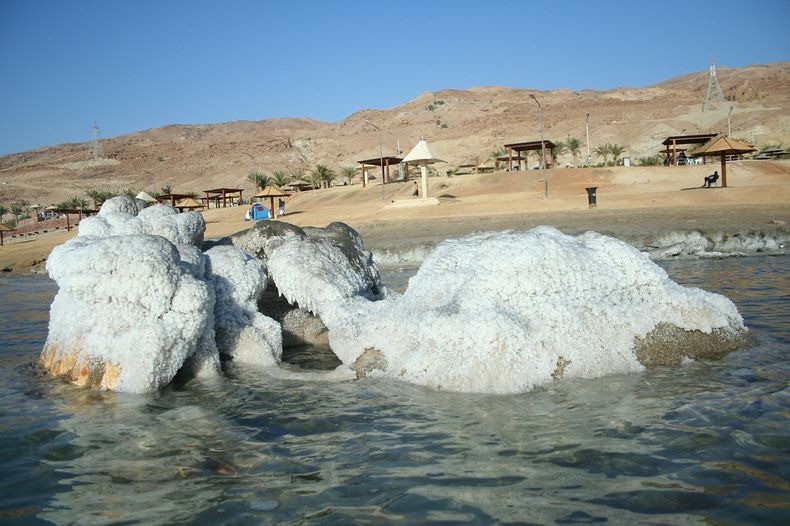
The Dead Sea is located in the Jordan valley bordering Jordan to the east and Israel and the West Bank to the west, and about 55 km southeast of Amman. Aside from the being the saltiest lake in the world, it is also Earth's lowest elevation on land. You have to descend 423 meters below sea level to reach its surface and shores. At 377 meters deep, it is also the deepest hypersaline lake in the world. Dead Sea has a salinity level of of 33.7%, which is 8.6 times saltier than the ocean. As much as 340 grams of salt is dissolved per liter of water. The extreme salt concentration prevents any kind of macroscopic aquatic life such as fish and plants to flourish here, though minuscule quantities of bacteria and microbial fungi are present. The water of the lake is so dense that it is impossible to sink in the Dead Sea. In fact, a popular fad among visitors is to have their picture taken while reading a newspaper and floating on the surface of the water.
The Dead Sea is fed by the Jordan river but there is no outlet. Salts have accumulated in the basin, sometimes by percolation through the surrounding earth, gradually building up over the centuries. The water contains more than 35 different types of minerals including magnesium, calcium, potassium, bromine, sulfur, and iodine. The odd chemistry results in the appearance of some striking, but transient, salt crystal formations. In shallow lagoons at periodic intervals, these formations are natural works of art: billions of charged atoms in intricate geometrical formations shaped by nature into unique works of crystalline art.
The most impressive of these natural sculptures are the "salt mushrooms" which stand on their halite or rock salt stems in shallow pools near the shoreline. Their hoods are circular to elliptical and the mushroom cap can reach up to half a meter in diameter. From afar they look like giant fungi sprouting from the water but closer inspection shows concentric rings of small, platy rectangular halite crystals with patchy crusts seated on hollow stalagmitic stems composed of what are called "pyramidical" crystals. Some formations have inverted pyramidical shapes protruding from the water, while others look like weathered columns.
Mushrooms usually begin to form on cool mornings, after periods of intense evaporation when the shallow lagoons become covered with floating rectangular halite crystals. The crystals blanket the surface of the water with an opaque, exceptionally delicate coating; the most gentle breeze can break this sheet and when it breaks, parts of it sink and the crystals attach themselves to plant debris or pebbles. Gradually, as a result, a stem of halite crystals begins to grow upwards, eventually reaching the surface where other crystals adhere to it and form the cap.

Because the ions and isotopes present in the water of the Dead Sea crystallize in different ways, there is a diverse array of natural formations. Hard, light-gray-to-brownish crusts of gypsum (hydrated calcium sulphate) can be seen on the keels of boats, on rocks, and on ropes left hanging in the water. The comparatively large, flat polygonal plates in gypsum crystals give rise to more crusty structures by clusters of calcite (crystalline calcium carbonate) which has crystals resembling small twinned needles; these needles lock together in forms resembling blossoms of white anemones. Along the shores of the Dead Sea variations in the forms depend on how ions are arranged within the structure and whether other ions or trace elements find their way into the lattice to substitute for particles with the same charge.
Even mundane compounds such as calcium carbonate can take on a spectacular appearance when an increase in temperature, often at the end of summer, triggers mass precipitation; the result is a dramatic whitening of the water as snowy clouds of the compound slowly descend to the sea bed. Turbulence and wave motion prolong the deposition of the crystals and give the water a striking, nebulous quality.
On some occasions, sheets of air bubbles form foam like surf on the ocean. At others times, chips of asphalt decorate the Dead Sea.
In recent decades, the Dead Sea has been rapidly shrinking as increasing amounts of water are drawn off from the streams and rivers flowing into the lake and used in agriculture, mining and industry. As the water level decreases, the characteristics of the Sea and surrounding region may substantially change. With the passage of time fewer of these natural formations and phenomena of the sea will remain. Already the evaporation rate exceeds the inflow rate and eventually the whole area will become mud flats.
In 2009 a project to conserve the Dead Sea was proposed. The plan is to convey seawater from the Red Sea, desalinate it along the route to provide fresh water to Jordan, with the brine discharge sent to the Dead Sea for replenishment. The project is anticipated to be completed by 2017.
Photo credit: Baz Ratner, Reuters



Sources: Wikipedia, Saudi Aramco World


























